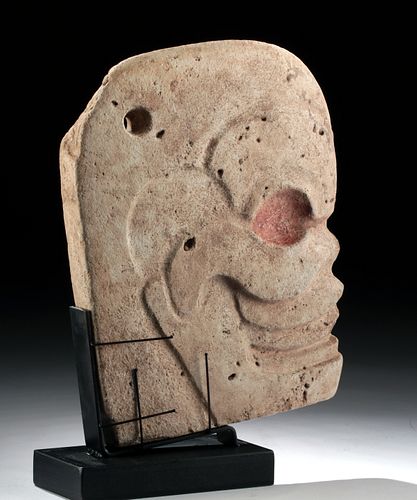Maya Stone Skull Hacha w/ Red Eye Orbitals
Lot 104d
About Seller
Artemis Gallery
686 S Taylor Ave, Ste 106
Louisville, CO 80027
United States
Selling antiquities, ancient and ethnographic art online since 1993, Artemis Gallery specializes in Classical Antiquities (Egyptian, Greek, Roman, Near Eastern), Asian, Pre-Columbian, African / Tribal / Oceanographic art. Our extensive inventory includes pottery, stone, metal, wood, glass and textil...Read more
Categories
Estimate:
$12,000 - $18,000
Absentee vs Live bid
Two ways to bid:
- Leave a max absentee bid and the platform will bid on your behalf up to your maximum bid during the live auction.
- Bid live during the auction and your bids will be submitted real-time to the auctioneer.
Bid Increments
| Price | Bid Increment |
|---|---|
| $0 | $25 |
| $300 | $50 |
| $1,000 | $100 |
| $2,000 | $250 |
| $5,000 | $500 |
| $10,000 | $1,000 |
| $20,000 | $2,500 |
| $50,000 | $5,000 |
| $100,000 | $10,000 |
| $200,000 | $20,000 |
About Auction
By Artemis Gallery
Feb 13, 2020
Set Reminder
2020-02-13 10:00:00
2020-02-13 10:00:00
America/New_York
Bidsquare
Bidsquare : Exceptional Antiquities, Asian, Ethnographic
https://www.bidsquare.com/auctions/artemis-gallery/exceptional-antiquities-asian-ethnographic-4848
An important one-day auction featuring museum-worthy examples of Egyptian, Greek, Roman, Etruscan, Near Eastern, Far East / Asian, Pre-Columbian, African / Tribal, Oceanic, Native American, Spanish Colonial, Russian, Fossils, Ancient Jewelry, Fine Art, so much more! Artemis Gallery info@artemisgallery.com
An important one-day auction featuring museum-worthy examples of Egyptian, Greek, Roman, Etruscan, Near Eastern, Far East / Asian, Pre-Columbian, African / Tribal, Oceanic, Native American, Spanish Colonial, Russian, Fossils, Ancient Jewelry, Fine Art, so much more! Artemis Gallery info@artemisgallery.com
- Lot Description
Pre-Columbian, Maya territories, ca. 500 to 950 CE. Carved on both sides, from a single piece of white stone with red pigment added to the eyes, a ceremonial hacha depicting a human skull in profile, of an overall flat form to resemble a symbolic axe but at the same time providing strong details, as the sculptor delineated so much of the skeletal framework protecting the brain including the frontal bone, orbital plate, nasal bone, maxilla, mandible, and occipital bone. A stupendous example for anyone who appreciates human anatomy and/or the ancients' penchant for the macabre! Size: 8.625" W x 10.625" H (21.9 cm x 27 cm); 12.25" H (31.1 cm) on included custom stand.
Hachas were associated with the ritual Mesoamerican ball game, though they were not actually part of the player's equipment. Instead these were worn during ritualistic ceremonies related to the game. The name stems from the fact that they were believed to be axe-heads; hence the term hacha (Spanish for axe). Based on ceramic figures and imagery on stone carvings, some authors have proposed that hachas were meant to be attached to yugos (yokes). Others suggest that some of the hachas could have served as ball court markers.
Provenance: ex-private Florida, USA physician’s collection, acquired 2000; ex-Major Elmer McBride collection, acquired 1947
All items legal to buy/sell under U.S. Statute covering cultural patrimony Code 2600, CHAPTER 14, and are guaranteed to be as described or your money back.
A Certificate of Authenticity will accompany all winning bids.
We ship worldwide and handle all shipping in-house for your convenience.
#153075Losses to peripheries and high pointed areas as shown. Wonderful red pigment remaining to highlight eye orbitals. Nice root marks and deposits grace the surface. Perforated through back of skull for attachment.Condition
- Shipping Info
-
All shipping is handled in-house for your convenience. Your invoice from Artemis Gallery will include shipping calculation instructions. If in doubt, please inquire BEFORE bidding for estimated shipping costs for individual items.
-
- Buyer's Premium



 EUR
EUR CAD
CAD AUD
AUD GBP
GBP MXN
MXN HKD
HKD CNY
CNY MYR
MYR SEK
SEK SGD
SGD CHF
CHF THB
THB














